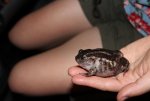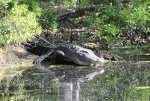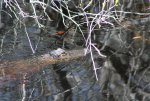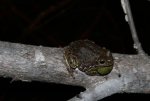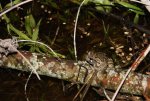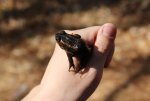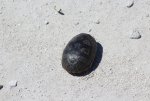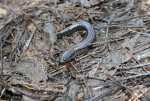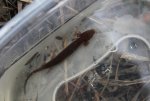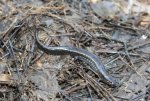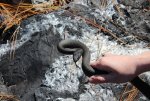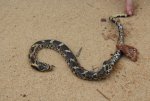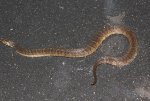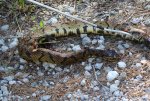Jefferson
Active member
- Joined
- Apr 21, 2012
- Messages
- 190
- Reaction score
- 28
- Points
- 28
- Location
- Southwest Missouri
- Country
- United States
This past Sunday, Bethany and I started down from the Virginia Piedmont toward the North Carolina Sandhills, outracing an approaching thunderstorm system through the verdant, blooming springtime forests of the foothills to the sounds of Glen Campbell, 80s rock, and bluegrass covers of John Denver. Our first spot, a blackwater stream cutting though the Sandhills, yielded a Dwarf Waterdog with a few swipes of the dipnet within twenty minutes, along with some skinks scurrying through the longleaf pine straw. The waterdog was my first lifer of the trip, and one that had eluded us twice previously. Dwarf Waterdogs are close relatives of the more northerly Common Mudpuppy, but can tolerate much warmer, less oxygenated water, like that which characterizes the Atlantic coastal plains and their streams. They reach nearly a foot at maximum, though our specimen barely topped four inches in length.
After photographing the waterdog, with thunder rolling in the western distance, we road cruised through the desolate Sandhills game lands as the winds signaled the oncoming storm, finding an Eastern Hognose, which had been hit by a vehicle, just before the rain began.
Then, the rain started, and it went from a drizzle to a certifiable torrent in less than a minute, making the sandy roads impassable by the time we exited back onto pavement in a series of harrowing puddle crossings. We checked into our quaint campground and prepared for the night road cruise that we both knew lay ahead of us with the thunder continuing outside. At twilight, we cruised some paved roads through marshy territory for a couple hours and found the following critters: Spade-foot toads (lifer), Fowler's toads, Southern toads, Southern leopard frogs, a giant bullfrog, spring peepers, a Squirrel tree frog (lifer), and a couple of snakes, including a feisty lifer Banded Watersnake. The last species on the list seems to imitate the Eastern Cottonmouth in body pattern, but is completely harmless, despite its nasty nonvenomous bite.
The next day, we checked some tin sites and field terrain in the Sandhills but turned up very little other than assorted skinks and anoles. Then, we drove east toward Fayetteville before heading north to meet up with someone who wanted to help us try to find a few of our target salamanders and chat taxonomic status with us. On the way to meet up, I penned a heping parody of Johnny Cash's "Folsom Prison Blues," which is now still in the refinement process. Upon reaching some spots our host knew, we sifted through lead litter along the margins of a swollen cypress swamp stream. Ordinarily shallow and slow, the swamp flowed swiftly and came up to the straight section of most of the bald cypress trees, a by-product of the driving road cruising rains the night before. We missed most of our target species due to the high water on the swamp margins, but still got a Three-lined Salamander on the sloped edges of the stream floodplain. This species lives in the Virginia Piedmont and all of the Carolinas and is of mixed abundance in various parts of its range, where it is usually sympatric with Two-lined Salamanders, one of which we also found in the moist leaf litter at the water's edge.
From here, we drove down to the Croatan National Forest vicinity through the coastal plain's mix of agricultural land flanked by pines and swampy lowlands in the orange late afternoon sunlight. Without time or adequate sunlight to hit any herping spots and the weather cooling off into the 40s, we decided to see the Atlantic Ocean, which roiled with twenty-five mph sustained winds. The smell of the sea hovered in the air near the coast, and the waves could be heard for hundreds of yards. Bethany and I looked out to sea as I wondered whether America can maintain control of the waves for my lifetime and marveled at the beauty of the sunset.
The next day, we met up with Phil Laxton, of Herper's Guide youtube fame in the herping community, to try to nail down some species on our list. Early efforts for some snakes proved futile due to the low temperatures, though we did see a few Southern racers, a lifer for me, and a few assorted lizards. The best part of herping with Phil Laxton throughout the day was the fact that he knew the Croatan National Forest so well, not just in geography and species makeup, but in the habits of the animals, of the rhythms of the forests and the longleaf savannas, of how the ecosystem responds to weather, of everything around him. Mr. Laxton has lived in the Croatan area for two decades, and it shows in his comfort and enthusiasm in herping his home region. Besides that, he also plays the mandolin and agreed to have a bluegrass and country jam with us the next time we're passing through North Carolina!
But as the afternoon wore on and the temperatures inched above sixty, our luck shifted. We nabbed an Eastern mud turtle crossing the road, saw yellow-bellied sliders galore, and at a bridge crossing where the sunlight came down unimpeded, there lay our first Alligator, a three or four-footer with a squeamish nature. As soon as he saw us, he jumped in the water with a thwack of the tail and stayed under a few minutes. He then surfaced on the other side of the canal, allowing me some photos.
We also technically saw a Spotted Turtle as well. I say "technically," because I saw it through binoculars for a split second before it slid into the water, and we got no decent pictures of this uncommon species, present in the South as well as my native Midwest in the early and mid-spring. We then hit a salamander spot that Phil knew of, but the high water made the floodplain forest, typically a hotspot for several swamp salamanders, completely inaccessible, though we did see a live Two-toed Amphiuma (of which we saw a dead one in Yorktown this past January 31) in a vernal pool on the way out. Continued road cruising turned up a DOR Glossy Crayfish snake, a beautiful species that only lives on the coast in NC, and an enormous Eastern Cottonmouth that had two small puncture wounds just behind its head, as if it had been shot or bitten by an Alligator. Ordinarily, getting such a close look at the highly venomous serpent would spell bad news for the observer, but with it sadly dead, we were able to get close-ups.
The Cottonmouth ended out our herping for day three, and we headed west back into the pinelands away from the coast, but still in the coastal plain, to our Airbnb location. The host chatted with us about immigration, the local fauna, his opinions on Lake Wacammaw's Alligators, taxes, college education, and religion before inviting us to have a bluegrass jam (which we did) before he left us to our rented space. Can't get that at a Motel 6! The next morning, we drove to Lake Wacammaw and cruised around the edge of the lake where a canal abuts the lakefront houses, where the Spanish moss hangs low and the alligators, I was told, would be abundant. They didn't disappoint. Our first was the eight footer that I'm using as the featured image for this post, and we saw twelve others by the time we finished cruising the canal (along with 131 turtles) in the morning sunlight. Further west at the edge of the coastal plain, after a long drive through North Carolina's fragrant hog country, we were dismayed to find our target park closed on Wednesdays and opted instead to frog around in the Sandhills (pun intended) for longer, setting a few traps on the campground owner's property and hitting a few extra spots. Her property gave us more Southern Black Racers under some discarded debris, more lizards, some cricket frogs (which are everywhere in the Sandhills), and four Southern Ring-neck snakes under some boards in a seep. This is what in herping is known as a "technical lifer." I have seen plenty of Northern Ring-neck snakes, which look almost exactly like the southern subspecies, but by virtue of range differences and very slight appearance differences, this counts as a lifer, whereas other "lifers" are completely new, like the Southern Dusky we'd find an hour or so later.
At a low swampy outflow drainage on adjacent public land, a random log flip yielded a miraculous lifer-the Southern Dusky Salamander. I'd given up hope on this one when the coastal locations we had ready were too flooded to access due to the rain, and the Sandhills are just the very periphery of their range. But this specimen came to us in perfect habitat, with the characteristic spotted belly, "portholes" above each costal groove, red-orange eye-jaw line, and dark coloration above. Though the taxonomy on these guys is a mess right now, there's no doubt that this specimen falls under what is currently recognized as the Southern Dusky Salamander.
I was ecstatic and euphoric as we moved to road cruising snakes once again. Nothing turned up on the roads or in some vernal pools we checked before dusk. On our way out, we got stuck behind a mule-drawn carriage bearing a North Carolina Civil War battle flag (the one that reads "May 20 1775-May 20, 1861), belonging to some recreational campers. But on the way back to camp, a near-miracle occurred. To our left, after hearing few frog calls other than leopards and peepers all evening, a chorus rang through the night and drowned out our music. I shut the car off and Bethany and I listened, picking out the species one at a time. Southern Toad, Spadefooot, Peeper, and.....something else.....Barking Treefrogs!!! These are some of North Carolina's rarest frogs, along with Pine Barrens Treefrogs and Gopher Frogs. We put on waders and went off-road, wading straight into the small two-foot deep pond, where persistence and slow pursuit eventually allowed me to sneak up on the Barking Treefrog, along with the more ubiquitous Cope's Gray Treefrog, which was a lifer for me because Michigan has the Common Gray, not Cope's, which dominate the South. We left that night extremely happy with the herping day despite its unpromising start.
The last morning in the Sandhills, we set some boards on private land (which gives snakes and salamanders cover) and checked our traps only to find that six of ten had been stolen in the night (One of the four non-stolen ones got a Carpenter Frog, a North Carolina specialty)!!
But no matter, it was still a great trip, and the Broken-striped newt eft we saw on our way out of the Sandhills that afternoon only served as an appropriate send-off back into Virginia as the crescent moon set over the pines on US route 1. Happy herping! Pictures are attached, and hopefully I'll get the youtube video up soon!
After photographing the waterdog, with thunder rolling in the western distance, we road cruised through the desolate Sandhills game lands as the winds signaled the oncoming storm, finding an Eastern Hognose, which had been hit by a vehicle, just before the rain began.
Then, the rain started, and it went from a drizzle to a certifiable torrent in less than a minute, making the sandy roads impassable by the time we exited back onto pavement in a series of harrowing puddle crossings. We checked into our quaint campground and prepared for the night road cruise that we both knew lay ahead of us with the thunder continuing outside. At twilight, we cruised some paved roads through marshy territory for a couple hours and found the following critters: Spade-foot toads (lifer), Fowler's toads, Southern toads, Southern leopard frogs, a giant bullfrog, spring peepers, a Squirrel tree frog (lifer), and a couple of snakes, including a feisty lifer Banded Watersnake. The last species on the list seems to imitate the Eastern Cottonmouth in body pattern, but is completely harmless, despite its nasty nonvenomous bite.
The next day, we checked some tin sites and field terrain in the Sandhills but turned up very little other than assorted skinks and anoles. Then, we drove east toward Fayetteville before heading north to meet up with someone who wanted to help us try to find a few of our target salamanders and chat taxonomic status with us. On the way to meet up, I penned a heping parody of Johnny Cash's "Folsom Prison Blues," which is now still in the refinement process. Upon reaching some spots our host knew, we sifted through lead litter along the margins of a swollen cypress swamp stream. Ordinarily shallow and slow, the swamp flowed swiftly and came up to the straight section of most of the bald cypress trees, a by-product of the driving road cruising rains the night before. We missed most of our target species due to the high water on the swamp margins, but still got a Three-lined Salamander on the sloped edges of the stream floodplain. This species lives in the Virginia Piedmont and all of the Carolinas and is of mixed abundance in various parts of its range, where it is usually sympatric with Two-lined Salamanders, one of which we also found in the moist leaf litter at the water's edge.
From here, we drove down to the Croatan National Forest vicinity through the coastal plain's mix of agricultural land flanked by pines and swampy lowlands in the orange late afternoon sunlight. Without time or adequate sunlight to hit any herping spots and the weather cooling off into the 40s, we decided to see the Atlantic Ocean, which roiled with twenty-five mph sustained winds. The smell of the sea hovered in the air near the coast, and the waves could be heard for hundreds of yards. Bethany and I looked out to sea as I wondered whether America can maintain control of the waves for my lifetime and marveled at the beauty of the sunset.
The next day, we met up with Phil Laxton, of Herper's Guide youtube fame in the herping community, to try to nail down some species on our list. Early efforts for some snakes proved futile due to the low temperatures, though we did see a few Southern racers, a lifer for me, and a few assorted lizards. The best part of herping with Phil Laxton throughout the day was the fact that he knew the Croatan National Forest so well, not just in geography and species makeup, but in the habits of the animals, of the rhythms of the forests and the longleaf savannas, of how the ecosystem responds to weather, of everything around him. Mr. Laxton has lived in the Croatan area for two decades, and it shows in his comfort and enthusiasm in herping his home region. Besides that, he also plays the mandolin and agreed to have a bluegrass and country jam with us the next time we're passing through North Carolina!
But as the afternoon wore on and the temperatures inched above sixty, our luck shifted. We nabbed an Eastern mud turtle crossing the road, saw yellow-bellied sliders galore, and at a bridge crossing where the sunlight came down unimpeded, there lay our first Alligator, a three or four-footer with a squeamish nature. As soon as he saw us, he jumped in the water with a thwack of the tail and stayed under a few minutes. He then surfaced on the other side of the canal, allowing me some photos.
We also technically saw a Spotted Turtle as well. I say "technically," because I saw it through binoculars for a split second before it slid into the water, and we got no decent pictures of this uncommon species, present in the South as well as my native Midwest in the early and mid-spring. We then hit a salamander spot that Phil knew of, but the high water made the floodplain forest, typically a hotspot for several swamp salamanders, completely inaccessible, though we did see a live Two-toed Amphiuma (of which we saw a dead one in Yorktown this past January 31) in a vernal pool on the way out. Continued road cruising turned up a DOR Glossy Crayfish snake, a beautiful species that only lives on the coast in NC, and an enormous Eastern Cottonmouth that had two small puncture wounds just behind its head, as if it had been shot or bitten by an Alligator. Ordinarily, getting such a close look at the highly venomous serpent would spell bad news for the observer, but with it sadly dead, we were able to get close-ups.
The Cottonmouth ended out our herping for day three, and we headed west back into the pinelands away from the coast, but still in the coastal plain, to our Airbnb location. The host chatted with us about immigration, the local fauna, his opinions on Lake Wacammaw's Alligators, taxes, college education, and religion before inviting us to have a bluegrass jam (which we did) before he left us to our rented space. Can't get that at a Motel 6! The next morning, we drove to Lake Wacammaw and cruised around the edge of the lake where a canal abuts the lakefront houses, where the Spanish moss hangs low and the alligators, I was told, would be abundant. They didn't disappoint. Our first was the eight footer that I'm using as the featured image for this post, and we saw twelve others by the time we finished cruising the canal (along with 131 turtles) in the morning sunlight. Further west at the edge of the coastal plain, after a long drive through North Carolina's fragrant hog country, we were dismayed to find our target park closed on Wednesdays and opted instead to frog around in the Sandhills (pun intended) for longer, setting a few traps on the campground owner's property and hitting a few extra spots. Her property gave us more Southern Black Racers under some discarded debris, more lizards, some cricket frogs (which are everywhere in the Sandhills), and four Southern Ring-neck snakes under some boards in a seep. This is what in herping is known as a "technical lifer." I have seen plenty of Northern Ring-neck snakes, which look almost exactly like the southern subspecies, but by virtue of range differences and very slight appearance differences, this counts as a lifer, whereas other "lifers" are completely new, like the Southern Dusky we'd find an hour or so later.
At a low swampy outflow drainage on adjacent public land, a random log flip yielded a miraculous lifer-the Southern Dusky Salamander. I'd given up hope on this one when the coastal locations we had ready were too flooded to access due to the rain, and the Sandhills are just the very periphery of their range. But this specimen came to us in perfect habitat, with the characteristic spotted belly, "portholes" above each costal groove, red-orange eye-jaw line, and dark coloration above. Though the taxonomy on these guys is a mess right now, there's no doubt that this specimen falls under what is currently recognized as the Southern Dusky Salamander.
I was ecstatic and euphoric as we moved to road cruising snakes once again. Nothing turned up on the roads or in some vernal pools we checked before dusk. On our way out, we got stuck behind a mule-drawn carriage bearing a North Carolina Civil War battle flag (the one that reads "May 20 1775-May 20, 1861), belonging to some recreational campers. But on the way back to camp, a near-miracle occurred. To our left, after hearing few frog calls other than leopards and peepers all evening, a chorus rang through the night and drowned out our music. I shut the car off and Bethany and I listened, picking out the species one at a time. Southern Toad, Spadefooot, Peeper, and.....something else.....Barking Treefrogs!!! These are some of North Carolina's rarest frogs, along with Pine Barrens Treefrogs and Gopher Frogs. We put on waders and went off-road, wading straight into the small two-foot deep pond, where persistence and slow pursuit eventually allowed me to sneak up on the Barking Treefrog, along with the more ubiquitous Cope's Gray Treefrog, which was a lifer for me because Michigan has the Common Gray, not Cope's, which dominate the South. We left that night extremely happy with the herping day despite its unpromising start.
The last morning in the Sandhills, we set some boards on private land (which gives snakes and salamanders cover) and checked our traps only to find that six of ten had been stolen in the night (One of the four non-stolen ones got a Carpenter Frog, a North Carolina specialty)!!
But no matter, it was still a great trip, and the Broken-striped newt eft we saw on our way out of the Sandhills that afternoon only served as an appropriate send-off back into Virginia as the crescent moon set over the pines on US route 1. Happy herping! Pictures are attached, and hopefully I'll get the youtube video up soon!

